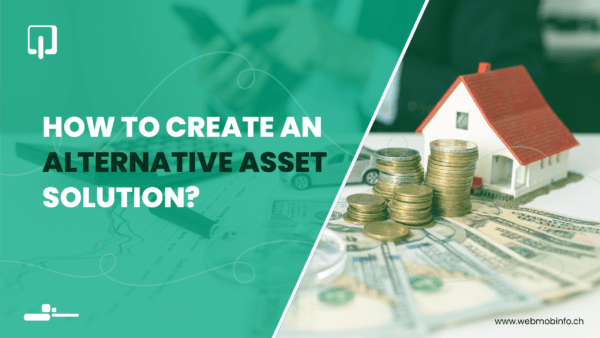By 2032, it is expected that the wealth management platform industry will have grown a lot and be worth more than $10 billion. This growth can be explained by the fact that banks and other financial institutions are using digital channels to offer their services. Currently, the human advisory sector dominates the market, accounting for 60% of the revenue. In the coming years, the cloud deployment model is expected to grow at a 15% CAGR from 2023 to 2032.
People want to invest in things other than stocks and bonds, so the need for wealth management platforms that let people invest in and manage real estate, private equity, hedge funds, commodities, and cryptocurrencies is growing. And with the growing market for alternative assets, there is a growing need for applications that make it easy for people to manage these investments.
This blog will explain the steps needed to make an alternative asset application, as well as its benefits, use cases, challenges, and opportunities.
Steps to Create an Alternative Asset Application
It is important to make an alternative asset application because it gives people a simple and easy way to invest in and manage alternative assets. With the growing demand for alternative investments and the increasing complexity of the alternative asset market, a well-designed app can help people make better investment decisions, reduce investment risk, and manage their assets more efficiently.
Let’s discuss the steps to create an alternative asset application
1. Conduct Market Research
Before building an application, it is important to understand the market and competition. This involves researching the target audience, market trends, and current offerings in the market. This research will help you determine the need for the application and identify any gaps in the market that the application can fill.
2. Define the characteristics
After doing market research, the next step is to decide what the application will do. The features should be designed to meet the needs of the target audience. This could include things like managing portfolios, getting real-time market data, news & analysis, planning taxes, and reporting.
3. Choose the Technology Stack
In the third step, you’ve got to choose the technology stack. It should be made up of the programming languages, databases, and frameworks that were used to build the application. The technology stack should be chosen based on the features defined in the previous step. For example, if the application requires real-time market data, then a technology stack that can handle large amounts of data quickly will be necessary.
4. Build the Application
With the technology stack in place, the next step is to build the application. This could mean making a user interface, making a database, and putting together market data feeds. It is important to focus on creating a user-friendly and secure application. And with more than eight years of experience, Webmob has the know-how to create and build innovative and efficient wealth management platforms that meet the growing demand for alternative assets.
5. Test and Launch
Before releasing the app, it’s important to test it thoroughly to make sure it meets the requirements and works the way it should. This could involve beta testing with a small group of users to get feedback and find any problems. Once the app has been tried out and any problems have been fixed, it can be made available to the public.
Benefits of an Alternative Asset Application
You can get a lot out of an alternative asset application. For example, it can give you real-time access to investment portfolios, which lets your users make smart investment decisions, track their performance, and make changes as needed, among other things. Let’s talk about a few good things about it.
1. Convenient Access: An alternative asset application provides users with real-time access to their investment portfolios, enabling them to view their investments, monitor performance, and make trades from anywhere, at any time.
2. Improved Transparency: An alternative asset application gives users a clear and concise overview of their investments. This helps them make better investment decisions and understand their overall financial picture.
3. Reduced Risk: By offering a streamlined and centralized view of alternative investments, an alternative asset application helps users manage their portfolio risk more effectively and make more informed investment decisions.
4. Increased efficiency: An alternative asset application can automate many of the manual tasks involved in managing alternative assets, such as keeping records, reporting, and tax planning. This can make it easier and take less time to manage other assets, giving users more time to work on other important tasks.
5. Improved Investment Outcomes: By providing users with real-time access to investment data and analytics, an alternative asset application can help users make more informed investment decisions and achieve better investment outcomes.
6. Access to Alternative Investments: An alternative asset application can give users access to a wide range of alternative investment products and services, allowing them to diversify their portfolios and possibly get better returns.
Use Cases of alternative asset application
The most important thing that makes alternative assets valuable is their use cases. They show what the specific needs and requirements of the target audience are, and you can leverage them. Some of the use cases for alternative assets are:
1. Portfolio Management: Portfolio management is one of the main ways that an alternative asset application is used. The application can provide users with real-time access to their investment portfolios, enabling them to view their investments, monitor performance, and make trades.
2. Investment Planning and Analysis: An alternative asset application can give users access to investment analytics and tools, which can help them make better investment decisions and plans for the future. This may include portfolio diversification tools, risk analysis tools, and tax planning tools.
3. Real-time Trading: The app gives users access to investment products and services in real time, making it easy for them to buy and sell alternative assets. This could mean having access to a wide range of alternative investment products, such as hedge funds, private equity funds, and real estate investment trusts.
4. Record Keeping and Reporting: An alternative asset application can automate many of the manual processes involved in managing alternative assets, such as record keeping and reporting. This can cut down on the time and work needed to manage alternative assets and make sure that users have access to accurate and up-to-date information.
5. Access to Expertise: An alternative asset application can give users access to investment experts like financial advisors, asset managers, and portfolio managers. This can help users make more informed investment decisions and achieve better investment outcomes.
6. Integration with Other Systems: An alternative asset application can be linked to other systems and platforms that users use, such as trading platforms, financial management tools, and tax planning software. This can provide users with a unified view of their investment portfolios and help them make more informed investment decisions.
Opportunities in the alternative asset market
After understanding the steps and benefits, it is also important for us to stay ahead of market trends and user needs, and ensure that the application remains relevant and valuable over time. And to do that, we have to constantly look for opportunities in the market. Such as:
1. Growing Market: The alternative asset market has been growing in recent years and is expected to continue to grow in the future. This gives alternative asset applications a great chance to tap into this growing market and help people keep track of their investments in alternative assets. As the market grows, there may be more demand for alternative asset applications and more people who could use them.
2. Innovative Solutions: The alternative asset market is constantly evolving, and there is an opportunity to create innovative solutions that meet the unique needs of alternative asset investors. This can include the integration of new technologies, such as blockchain, and the creation of new investment products and services. By offering innovative solutions, the application can differentiate itself from competitors and attract a larger user base.
3. Increased Adoption: As more people become interested in alternative assets, there is an opportunity for the application to increase its user base and reach a larger audience. By providing a user-friendly interface and valuable features, the application can encourage increased adoption and attract new users. Additionally, by actively promoting the application and building a strong brand, the development team can increase awareness and drive adoption.
4. Partnerships and Collaborations: There is an opportunity to forge partnerships and collaborations with other companies, organizations, and institutions that are involved in the alternative asset market. This can help expand the reach of the application and bring in new users.
5. Data analytics: The development team can learn a lot about what alternative asset investors want and need by collecting and analyzing data about how users act and how the market is changing. This can inform future development and help the application stay ahead of the curve.
6. Diversification: Alternative assets offer investors the opportunity to diversify their portfolios and reduce risk. An alternative asset application can help users identify and invest in a wider range of alternative assets, providing greater diversification and the potential for higher returns.
Conclusion
Anybody who wants to invest in and manage alternative assets can benefit from making an alternative asset application. But the process needs careful thought about the market, the people you want to reach, and the technology stack.
The app must also be built and designed with security and compliance with regulations in mind. It must also come up with new ways to help investors in alternative assets meet their specific needs. The growing alternative asset market and the growing demand for alternative investment solutions make it possible for the application to reach a large audience and grow over time.
If you want to build an alternative asset application to upgrade your trading stack, you’ve come to the right spot. Webmob Software Solutions has worked on a variety of trading platforms for more than seven years, and we can offer cutting-edge solutions that cover every aspect of trading platforms.
Chahat has a deep passion for leveraging blockchain technology to drive innovation and transformation. With over seven years of experience, she has been instrumental in guiding WebMob through the complexities of blockchain adoption. Her expertise and forward-thinking approach make her a key thought leader in the blockchain space, paving the way for a modern decentralized industry.

